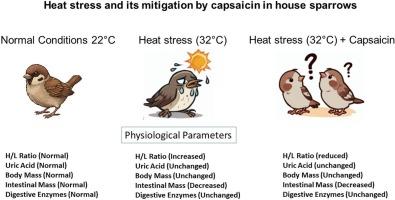辣椒素对家雀健康状况和消化酶的影响及缓解
IF 2.2
3区 生物学
Q4 BIOCHEMISTRY & MOLECULAR BIOLOGY
Comparative Biochemistry and Physiology A-Molecular & Integrative Physiology
Pub Date : 2025-07-26
DOI:10.1016/j.cbpa.2025.111909
引用次数: 0
摘要
由于气候变化,热浪和暖期在世界范围内发生,破坏了动物的体内平衡,导致热应激。因此,动物必须对这些变化作出反应,以确保它们的生存。这种反应包括一些生理变化,如释放糖皮质激素和儿茶酚胺,以恢复体内平衡。由于缺乏对野生鸟类这一问题的认识,本研究的目的是研究热应激对家雀(Passer domesticus)身体状况和消化系统的影响。此外,由于辣椒素被用作家禽的添加剂来缓解热应激,并且它是家鸟饲养者在种子中常见的添加剂,以防止松鼠吃它们的食物,本研究的第二个目标是辣椒素作为膳食添加剂在缓解热应激方面的可能作用,并检查辣椒素在消化系统中的作用。在这项工作中,我们测量了嗜异性粒细胞/淋巴细胞比率(H/L比率)作为应激的代表;32±2℃应激条件下和22±2℃正常条件下的体重、红细胞压积、尿酸和消化酶(肠道和胰腺)。此外,我们评估了辣椒素在两种情况下(32°C和22°C正常条件下的热应激)的作用。热应激使H/L比升高,而辣椒素使H/L比降低。虽然在32°C环境下观察到肠道体积的减少,但消化酶活性在热应激或辣椒素处理下没有变化。提高这一领域的知识不仅与动物营养和兽医学有关,也与野生鸟类有关,因为在野生鸟类中,探索针对未来全球变暖情景的潜在缓解战略至关重要。本文章由计算机程序翻译,如有差异,请以英文原文为准。

Impacts of heat stress and its mitigation by capsaicin in health status and digestive enzymes in house sparrows (Passer domesticus)
Heatwaves and warm spells occurring worldwide as a result of climate change disrupt the homeostasis of animals, leading to heat stress. Consequently, animals must respond to these alterations in order to ensure their survival. The response involves several physiological changes, such as releasing of glucocorticoids and catecholamines, to restore homeostasis. Due to the lack of knowledge on this subject in wild birds, the objective of the present work was to study the effect of heat stress on body condition and digestive system in house sparrows (Passer domesticus). In addition, since capsaicin is used as additive in poultry to mitigate heat stress and it is a common additive in seeds for house birdfeeders to prevent squirrels from eating their food, the second objective of this study was a possible role of capsaicin as a dietary additive in mitigating heat stress and to check the effect of capsaicin in digestive system. In this work, we measured heterophil/lymphocytes ratio (H/L ratio) as a proxy of stress; body mass, hematocrit, uric acid and digestive enzymes (intestinal and pancreatic) under stress conditions at 32 ± 2 °C and under normal conditions at 22 ± 2 °C. In addition, we evaluated the effect of capsaicin in both situations (heat stress at 32 °C and normal condition 22 °C). We found an increase of H/L ratio under heat stress, and decrease of H/L ratio with capsaicin on animals exposed to heat stress. Although a loss of intestinal mass was observed in animals exposed at 32 °C, digestive enzyme activity does not change under heat stress or under capsaicin administration. Improving knowledge in this field is relevant at the level of animal nutrition and veterinary medicine, while also bearing relevance for wild birds, where it becomes crucial to explore potential mitigation strategies for future global warming scenarios.
求助全文
通过发布文献求助,成功后即可免费获取论文全文。
去求助
来源期刊
CiteScore
5.00
自引率
4.30%
发文量
155
审稿时长
3 months
期刊介绍:
Part A: Molecular & Integrative Physiology of Comparative Biochemistry and Physiology. This journal covers molecular, cellular, integrative, and ecological physiology. Topics include bioenergetics, circulation, development, excretion, ion regulation, endocrinology, neurobiology, nutrition, respiration, and thermal biology. Study on regulatory mechanisms at any level of organization such as signal transduction and cellular interaction and control of behavior are also published.

 求助内容:
求助内容: 应助结果提醒方式:
应助结果提醒方式:


